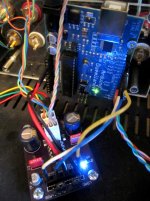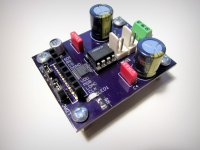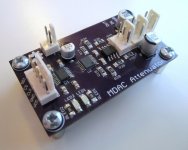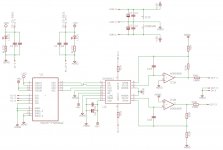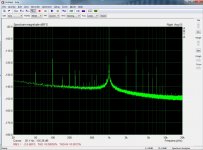I've been testing the DAC8812 based module for the last couple days and it's really good:
- No clicks, pops or any noise.
- Drives my headphones really well.
- Sounds good!
I also used it as a preamp for some UcD180HGs and it sounds and works well.
My current code: dac_level = 65536*(pow(10, (dbLevel/20)));
Gives ~300 steps at 0.25dB or ~160 steps at 0.5dB.
It's not exactly log but it works perfectly fine. It's really fast to make changes, no delay at all.
I also tried to measure it using RMAA but it is beyond the limits of the line input of my computer (which is -87dB noise level, 89dB dynamic range, 0.0041% THD).
- No clicks, pops or any noise.
- Drives my headphones really well.
- Sounds good!
I also used it as a preamp for some UcD180HGs and it sounds and works well.
My current code: dac_level = 65536*(pow(10, (dbLevel/20)));
Gives ~300 steps at 0.25dB or ~160 steps at 0.5dB.
It's not exactly log but it works perfectly fine. It's really fast to make changes, no delay at all.
I also tried to measure it using RMAA but it is beyond the limits of the line input of my computer (which is -87dB noise level, 89dB dynamic range, 0.0041% THD).
Attachments
I designed a version with gain in the I/V stage, 12dB. It works really well. I also used an ADUM7440 for SPI isolation from the Arduino. I've taken measurements using my E-MU 0404 USB and it measures better than a PGA2320 🙂
Attachments
Last edited:
None, it sounds transparent to me. I'm not a fan of subjective descriptions of sound and the designer/creator is probably the most biased person to give such a description anyway.what kind of 'character' does the sound have?
Hi,
just realized this MDAC is also used in moon 600i 700i as ther m-evol 2 technology...
so you got very inspired to go with this one ! are you still on a "moon" 🙂 with it
just realized this MDAC is also used in moon 600i 700i as ther m-evol 2 technology...
so you got very inspired to go with this one ! are you still on a "moon" 🙂 with it
True. Never heard of Sim Audio or Moon but yes it looks like they also use the same design:
This volume control circuit is based on the R-2R resistor array configuration and uses high-quality thin metal film surface mount resistors with 0.1% tolerances. The entire process is microcomputer controlled via a discrete relay network.
MOON - Education - Preamplifiers
Their module looks really similar to the Mark Levinson one with IV opamps at one end of a series of analog switches in a row:
This volume control circuit is based on the R-2R resistor array configuration and uses high-quality thin metal film surface mount resistors with 0.1% tolerances. The entire process is microcomputer controlled via a discrete relay network.
MOON - Education - Preamplifiers
Their module looks really similar to the Mark Levinson one with IV opamps at one end of a series of analog switches in a row:
An externally hosted image should be here but it was not working when we last tested it.
An externally hosted image should be here but it was not working when we last tested it.
Yes, been using it for 6 months now, works great!are you still on a "moon" 🙂 with it
good to hear ! this is inspiring my DSP-DAC-VOL design
in fact the other Moon version called "M-eVOL2 Volume"
is more equivalent to your version, just look some line below in the link you posted 🙂
in fact the other Moon version called "M-eVOL2 Volume"
is more equivalent to your version, just look some line below in the link you posted 🙂
An externally hosted image should be here but it was not working when we last tested it.
Volume control without a DAC
The Germans back right after the war did produce some great audio gear. And faders too. Look at this page
Magnetophon-operation
somewhere on 1/3 of the page, you see the 'Regler'. This thing is a fader, a resistive volume control. From an impedance point of view it is done in such a way that the input impedance *and* the output impedance are similar, NO MATTER where the fader is positioned. The reason is.... Transformers. Often there were transformers as coupling devices (to avoid hum). The performance of transformers is depending of the impedance load or source. This fader solved that problem. And... No electronics. From a mechanical point of view it is horrific to reproduce, of course ;-)
Just wanted to share this.
The Germans back right after the war did produce some great audio gear. And faders too. Look at this page
Magnetophon-operation
somewhere on 1/3 of the page, you see the 'Regler'. This thing is a fader, a resistive volume control. From an impedance point of view it is done in such a way that the input impedance *and* the output impedance are similar, NO MATTER where the fader is positioned. The reason is.... Transformers. Often there were transformers as coupling devices (to avoid hum). The performance of transformers is depending of the impedance load or source. This fader solved that problem. And... No electronics. From a mechanical point of view it is horrific to reproduce, of course ;-)
Just wanted to share this.
Here's a different idea...
How about using a rotary encoder and code that determine the number of steps by how fast you turn the knob? Get a big heavy knob and it should give a nice tactile feedback while turning it. 🙂
This way you get all the fine tuning you want by turning it slowly.
How about using a rotary encoder and code that determine the number of steps by how fast you turn the knob? Get a big heavy knob and it should give a nice tactile feedback while turning it. 🙂
This way you get all the fine tuning you want by turning it slowly.
I designed a version with gain in the I/V stage, 12dB. It works really well. I also used an ADUM7440 for SPI isolation from the Arduino. I've taken measurements using my E-MU 0404 USB and it measures better than a PGA2320 🙂
Could you share the pcb files or sell it ?
It's all open source. Details in this thread: My new preamp design: Arduino, 6 input selector, MDAC attenuator, IR etc
And PCB files are here: GitHub - FutureSharks/preamp-two: An digitally controlled hi fi preamplifier 🔈🎵
And PCB files are here: GitHub - FutureSharks/preamp-two: An digitally controlled hi fi preamplifier 🔈🎵
I'm planning on building your MDAC attenuator design. I just cloned your preamp-two repo on github and am learning how to use KiCad5. Are there any resistors in the MDAC
attenuator circuit that need to be better than 1%? Any chance you have BOM lists with Digikey/Mouser/etc part numbers to speed up the parts order process?
attenuator circuit that need to be better than 1%? Any chance you have BOM lists with Digikey/Mouser/etc part numbers to speed up the parts order process?
- Home
- Source & Line
- Analog Line Level
- Solid state R2R attenuator using analog switches or multiplying DAC
